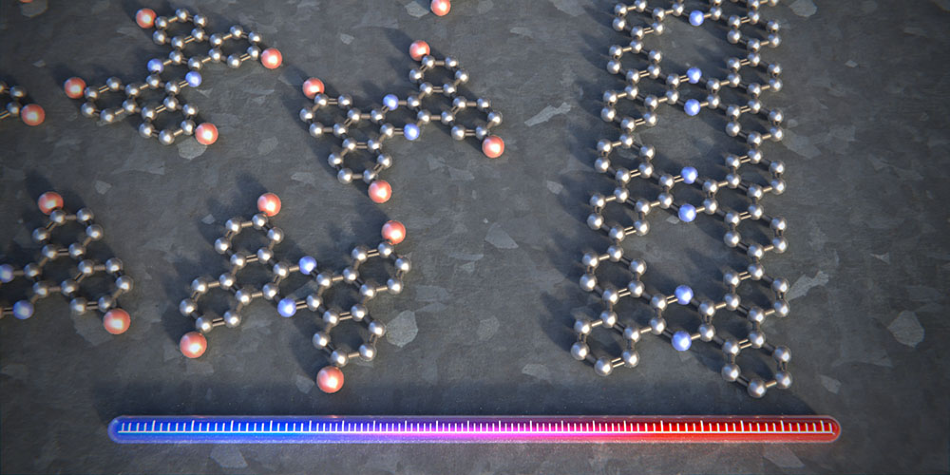Jul 9 2020
The first-ever porous graphene ribbons have been produced by a group of chemists and physicists with certain carbon atoms present in the crystal lattice replaced with nitrogen atoms.
 The individual building blocks are heated on a silver surface in order to synthesize a porous graphene ribbon that exhibits semiconducting properties and a ladder-like structure. In each rung of the ladder, two carbon atoms have been replaced with nitrogen atoms (blue). Image Credit: University of Basel, Department of Physics.
The individual building blocks are heated on a silver surface in order to synthesize a porous graphene ribbon that exhibits semiconducting properties and a ladder-like structure. In each rung of the ladder, two carbon atoms have been replaced with nitrogen atoms (blue). Image Credit: University of Basel, Department of Physics.
Such ribbons exhibit semiconducting properties, making them appealing for applications in quantum computing and electronics, as stated by scientists from the Universities of Basel, Bern, Lancaster, and Warwick in the Journal of the American Chemical Society.
In graphene, a single layer of carbon atoms is arranged in a honeycomb structure. The material has gained attention not only in fundamental research but also for several applications for its exclusive properties, such as exceptional electrical conductivity and surprising rigidity and strength.
Across the globe, different research groups have been making efforts to further expand such characteristics by replacing carbon atoms in the crystal lattice using atoms of various other elements. Additionally, the magnetic and electric properties can also be altered by introducing pores in the lattice.
Ladder-Like Structure
At present, a research group under the guidance of the physicist Professor Ernst Meyer of the University of Basel and the chemist Dr Shi-Xia Liu from the University of Bern has been successful in creating the first graphene ribbons with a crystal lattice that includes both periodic pores and a uniform pattern of nitrogen atoms.
The new material’s structure resembles a ladder, where two nitrogen atoms are placed in every rung. The researchers synthesized such porous, nitrogen-containing graphene ribbons by heating the separate building blocks stepwise on a silver surface in a vacuum.
The ribbons are created at temperatures of up to 220 °C. Using atomic force microscopy, the team not only tracked the separate steps in the synthesis but also verified the ideal ladder structure, and stability, of the molecule.
Extraordinary Properties
The researchers from the Department of Physics and the Swiss Nanoscience Institute (SNI) at the University of Basel used scanning tunneling microscopy to show that the newly developed graphene ribbons were no more electrical conductors, similar to pure graphene, but acted as semiconductors.
Collaborators from the Universities of Bern and Warwick verified the study findings by carrying out theoretical calculations of the electronic properties.
The semiconducting properties are essential for the potential applications in electronics, as their conductivity can be adjusted specifically.
Dr Rémy Pawlak, Study First Author, University of Basel
Previous studies show that a high concentration of nitrogen atoms in the crystal lattice makes the graphene ribbons to magnetize when a magnetic field acts on them.
We expect these porous, nitrogen-doped graphene ribbons to display extraordinary magnetic properties. In the future, the ribbons could therefore be of interest for applications in quantum computing.
Ernst Meyer, Physicist and Professor, University of Basel
Journal Reference:
Pawlak, R., et al. (2020) Bottom-up Synthesis of Nitrogen-Doped Porous Graphene Nanoribbons. Journal of the American Chemical Society. doi.org/10.1021/jacs.0c03946.